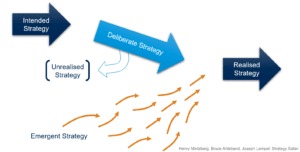I’ve been working my way through Strategy Safari by Henry Mintzberg, Bruce Ahlstrand and Joseph Lampel. My initial curiosity was around how they describe Emergent Strategy, as pictured to the right, as a way of characterising Strategy Deployment. In the end, my biggest takeaway was a set of six strategy deployment steps that I wasn’t previously aware of. Admittedly, they’ve been around since the 1990’s so arguably they’re not that revolutionary. However, they could have made a huge difference if they had been better known.
Strategy Schools
The book describes 10 “Schools” of strategy which I’ll list for completeness:
- The Design School: strategy formation as a process of competition
- The Planning School: strategy formation as a formal process
- The Positioning School: strategy formation as an analytical process
- The Entrepreneurial School: strategy formation as a visionary process
- The Cognitive School: strategy formation as a mental process
- The Learning School: strategy formation as an emergent process
- The Power School: strategy formation as a process of negotiation
- The Cultural School: strategy formation as a collective process
- The Environmental School: strategy formation as a reactive process
- The Configuration School: strategy formation as a process of transformation
I was expecting the Learning School to be the most relevant as being closest to my views on Strategy Deployment as an emergent process. However, I was most surprised by the Configuration school, which provided the big takeaway. Given I generally work in the context of Agile Transformations I found this a particularly interesting perspective, with transformations being between configurations
Managing Change
This view of transformation leads to the concept of managing change between configurations, and this quote jumped out at me:
the best way to ‘manage’ change is to allow for it to happen – to set up the conditions whereby people will follow their natural instincts to experiment and transform their behaviors.
Strategy Safari: Mintzberg, Ahlstad and Lampel
This particularly resonated with me because it reminded me of something Dave Snowden says. I’m probably paraphrasing slightly, but it’s something like “We need to change the energy gradient so that it is easier to do the right thing than do the wrong thing.”
Top-Down v. Bottom-Up
That is all context for the big takeaway. In a discussion of top-down versus bottom-up change, the authors mention two HBR articles that appeared around the same time. One is “Leading Change: Why Transformation Efforts Fail” by John Kotter. The other is “Why Change Programs Don’t Produce Change” by Russell Eisenstat, Bert Spector, and Michael Beer. I’m pretty sure most people have come across Kotter’s “Eight Steps to Transforming Your Corporation”. Especially because SAFe references it heavily. Additionally, I suspect that not many people will have heard of Eisenstat, Spector and Beer’s “Six Steps to Effective Change”. I certainly hadn’t.
What I found telling was that Kotter’s Eight Steps are identified as being more top-down transformation. That’s certainly how I see it played out in most cases. Conversely, Eisenstat, Spector and Beer’s Six Steps are identified as being more bottom-up transformation. As such, I find these more coherent with the way I think about Strategy Deployment. And as a result, they have the potential to be a set of Strategy Deployment steps.
The Six Strategy Deployment Steps
These are the six steps, with my thoughts on how I interpret them in terms of Strategy Deployment steps.
Mobilise commitment to change through joint diagnosis of business problems.
The language of diagnosis is consistent with Rumelt‘s Strategy Kernel of Diagnosis, Guiding Policies and Coherent Action. Therefore, starting with a diagnosis like this is equivalent to starting with Sensemaking and Situational Awareness (e.g. Estuarine Mapping and Wardley Mapping).
Develop a shared vision of how to organize and manage for competitiveness.
This is where the initial Strategy starts to emerge. Again referring to Rumelt’s Strategy Kernel, it’s the formation of the Guiding Policies.
Foster consensus for the new vision, competence to enact it, and cohesion to move it along.
This is the deployment of the strategy through Catchball. As an example, Backbriefing, with its two-way dialogue, is a great means to begin creating consensus, competence and cohesion.
Spread revitalization to all departments without pushing it from the top.
Treating the tactical implementation of the strategy as experimentation avoids top-down transformation. Thus the actual solutions emerge from the people closest to the problems.
Institutionalize revitalization through formal policies, systems, and structures.
This is the communication of the learning from the solutions as they emerge. Additionally, with that communication is the adoption of standards based on the learning. Note that by standards I mean a current best way, rather than the perpetual best way. In Cynefin terms, this is the dynamic which shifts from Complex to Complicated.
Monitor and adjust strategies in response to problems in the revitalization process.
This is Strategy Deployment as Continuous Strategy. Thus there remains a need to sustain the diagnosis, sensemaking and situational awareness. In other words, while these are described as six Strategy Deployment steps, they should be used in an ongoing and non-linear manner. There might be a shift back into Complex.
Conclusion
It’s notable that Kotter’s Eight Steps and Eisenstat, Spector and Beer’s Six Steps were both published around the same time and by colleagues at the Harvard Business School. And despite that, only one – the top-down one – has become popular. I can’t help wondering how different many SAFe transformations would be if it had been the other way around. Personally, I prefer these six Strategy Deployment steps.

